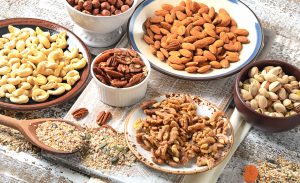
by Samantha Kennedy | Nov 15, 2024
Maintaining a healthy diet can be challenging, especially for individuals managing high blood sugar levels. Choosing the right snacks is crucial for avoiding blood sugar spikes and keeping energy levels stable throughout the day. Here, we explore several healthy snack options that are both delicious and beneficial for those with high blood sugar.

Snacks high in protein, fiber, and healthy fats such as nuts and seeds are a healthy choice for people looking to manage their high blood sugar. (Source: Adobe Stock photo)
Nuts and seeds. These foods are excellent snacks for people with high blood sugar. Almonds, walnuts, flaxseeds, and chia seeds are rich in fiber, healthy fats, and protein, which help stabilize blood sugar levels. A handful of almonds or a tablespoon of chia seeds in a smoothie can keep you feeling full and satisfied without causing a spike in blood sugar. Additionally, these snacks are packed with vitamins and minerals that contribute to overall health.
Fresh vegetables. Foods like carrots, celery, and bell peppers are low in calories and carbohydrates, making them ideal for blood sugar management. These veggies are high in fiber and water content, which help in maintaining a feeling of fullness. Pairing them with hummus or a Greek yogurt dip adds protein and flavor, creating a balanced and tasty snack option.
Berries. Foods such as strawberries, blueberries, and raspberries are not only delicious but also have a low glycemic index, meaning they do not cause significant spikes in blood sugar. Rich in antioxidants, vitamins, and fiber, a small bowl of mixed berries can be a satisfying snack. For added protein, consider combining them with a small portion of Greek yogurt or cottage cheese.
Whole-grain crackers and avocado. This combination provides a perfect balance of complex carbohydrates, healthy fats, and fiber. Whole grains help slow digestion, preventing sudden increases in blood sugar levels, while avocados offer monounsaturated fats that are heart-healthy and satisfying. Sprinkle some chia or sesame seeds on top for an extra nutritional boost.
Greek yogurt. This very versatile snack is high in protein and lower in sugar compared to regular yogurt. It is an excellent option for people with high blood sugar, as protein can help slow the absorption of carbohydrates, thereby preventing spikes. For a more filling snack, add a handful of nuts or fresh berries to a cup of Greek yogurt.
Hard-boiled eggs. This is a simple and convenient snack option packed with high-quality protein and healthy fats. They can help stabilize blood sugar levels and keep hunger at bay. Sprinkle a little salt and pepper or enjoy them with a side of fresh veggies for a complete snack.
Edamame. Also known as steamed soybeans, these are an excellent snack choice for those managing high blood sugar. They are high in protein, fiber, and essential vitamins and minerals. A half-cup serving of edamame provides a satisfying and nutritious snack that supports blood sugar control.
For individuals with high blood sugar, mindful snacking is essential to maintaining stable glucose levels and overall health. By choosing nutrient-dense, low-glycemic snacks such as nuts, fresh vegetables, berries, whole grains, Greek yogurt, hard-boiled eggs, and edamame, it is possible to enjoy delicious and satisfying snacks without compromising blood sugar control. Incorporating these healthy options into your daily routine can make a significant difference in managing high blood sugar effectively.
For more information about healthy eating for people with or without high blood sugar, please contact Samantha Kennedy, County Extension Director, at 850.926.3931.
An Equal Opportunity Institution.

by Suzanne Holloway | Nov 15, 2024
Thanksgiving, like other holidays, promises gratitude and togetherness, but it can also bring stress, awkward moments, and even indigestion. As family members gather – from near and far – to share a meal, navigating conflicting personalities, differing opinion, and the drive for perfection can make hosting feel daunting. To help ensure a peaceful (and maybe even enjoyable) holiday, here are a few Thanksgiving dos and don’ts.
DOs
- Set Realistic Expectations. While many dream of a picture-perfect Thanksgiving, real life is rarely like a cheesy holiday movie. Accept that things might not go as planned, and those imperfections are perfectly fine. Instead of pursuing perfection, aim for a day where everyone has moments of enjoyment, even if brief.
- Plan Ahead. Hosting Thanksgiving can be overwhelming—you’re the cook, cleaner, and event planner all in one. Schedule tasks into manageable chunks over the course of a few days, prepping dishes in advance, and delegating responsibilities. Ask your guests to bring sides – this lightens your load and involves them in the holiday prep.
- Choose Your Seat Wisely. Sit near family members you get along with. If you’re arranging seating, separate personalities likely to clash to keep the atmosphere peaceful.
- Take Care of Yourself. Schedule time for yourself before, during, and after Thanksgiving. It can be a short walk, meditating, or a quick and quiet escape to play a video game or watch a movie. If you are unable to leave a stressful situation, calm yourself with five slow, deep breaths.
- Learn to Let Things Go. Family quirks and annoyances are part of the package. Practice patience and remember, it’s just for a short time.
- Remember the Reason for the Season. Reflect on or share what you are thankful for—whether it’s a good meal, health, a roof over your head, or time with loved ones. Focusing on gratitude can be a great tool to shift the mood toward positivity.
DON’Ts
- Dominate the Conversation. Thanksgiving is for catching up with friends and family, not just talking about yourself. Be mindful, and make space for others to share, especially if it’s been a while since you have seen them.
- Try to Fix Problems. Now is not the time for unsolicited advice or life coaching. One conversation over what is supposed to be a happy meal won’t mend a marriage, convince someone to start a family, make someone a better parent, or get them to hit the gym.
- Discuss Sensitive Topics. Subjects like politics, religion, or lifestyle choices are best left off the dinner table. Even well-meaning questions like “When are you getting married?” or “When can I expect grandchildren?” may seem innocent but can make people uncomfortable. Stick to lighter topics that bring people together, such as favorite family traditions, upcoming plans, or funny memories from past Thanksgivings, this helps create a positive, welcoming environment for everyone.
- Drink Excessively. Some people become argumentative or aggressive when drinking, which can escalate tensions. Avoid these individuals if they get rowdy, and prevent them from driving. If this is an issue for you, consider mocktails or non-alcoholic drinks.
Thanksgiving does not have to be a stressful situation. By prioritizing your well-being and keeping gratitude at the forefront of the celebration, you can make Thanksgiving a meaningful, enjoyable day—flaws and all.
Additional Sources

by Suzanne Holloway | Nov 15, 2024
As leaves change color and days grow shorter, seasonal depression can start affecting some individuals. Seasonal Affective Disorder (SAD), a type of depression with seasonal patterns, often begins in young adulthood and becomes more likely with age, especially for those aged 18 to 30. An estimated 5% of adults in the U.S. experience SAD, with higher rates among people assigned female at birth. Risk factors include having another mood disorder, family history of SAD or other mental health conditions, living far from the equator, or residing in cloudy regions, all of which can increase susceptibility. There are two types of SAD: winter depression and summer depression. Winter depression occurs during the late fall to early winter months. Summer depression is less prevalent, with symptoms starting in late spring to early summer.
Seasonal Depression Symptoms
- Sadness
- Anxiety
- Feeling hopelessness
- Difficulty concentrating
- Increased appetite and weight gain
- Fatigue
- Social withdrawal
- Loss of interest in pleasurable activities
- Issues with sleeping (oversleeping)
- Irritability
- Thoughts of suicide or death
Those who experience summer seasonal depression may also experience:
- Insomnia
- Decreased appetite
- Violent outbursts
While the exact cause of seasonal depression remains unclear, several theories link it to reduced sunlight and shorter winter days. Shorter days disrupt the body’s internal clock, or circadian rhythm, which affects mood, sleep, and hormone levels. Neurotransmitters, brain chemicals, including melatonin and serotonin, can become imbalanced. As winter brings longer periods of darkness, melatonin (a sleep-related hormone) increases, which may may contribute to sluggishness and fatigue. Sunlight and vitamin D help stimulate the production of serotonin (a mood-related hormone); therefore, vitamin D deficiency and reduced sun exposure can impact serotonin levels and mood. Additionally, those with SAD may also experience negative thoughts associated to the season, though it’s unclear if these thoughts are a cause or a result of the condition.
If you’re experiencing symptoms of Seasonal Affective Disorder (SAD), consult your healthcare provider for an evaluation. They may refer you to a mental health professional, as SAD can sometimes be part of a broader mental health condition. Additionally, if you or someone you know is struggling with thoughts of suicide or needs immediate help, dial 988 for free, confidential support.
Sources:

by Melanie Taylor | Aug 28, 2024
School is back in session. The long days of summer and not following a schedule have come to an end. It is important to help your child/teenager get back on a regular schedule and into a normal sleep routine.
Busy lifestyles filled with school, afterschool, and evening activities have become the norm in the American culture. But these demanding hours of multi-tasking are negatively affecting many of our daily lives. If it affects us as adults, what must it be doing to our children and teens? Overlooking the importance of sleep is damaging to our mental, physical, and cognitive health.
Sleep is a crucial biological function. It plays a significant role in restoring and recovering the body systems, improving learning and memory, and healthy brain development.

(Photo source: Adobe Stock)
Sleep deprivation can lead to physical and behavioral symptoms that can be misdiagnosed as more severe mental and behavioral disorders. Children who do not get enough sleep may not physically appear to be sleepy. However, they may struggle with attentiveness, hyperactivity, aggression, or disruptive behavior. Sleep deprivation also reduces the immune system’s ability to defend against colds and the flu.
Tips for good sleep habits for children and families include:
- Make sleep a respected priority.
Establish a consistent, relaxing bedtime routine.
- Consistency is key for regular daytime and bedtime routines for sleep.
Attempt to maintain a regular sleep and wake schedule, including on weekends.
- Provide children with positive attention before bedtime.
This may reduce conflict or resistance to bedtime routines.
- Keep bedrooms dark, cool, and quiet.
Do not have a TV, computer, or cellphone in the room.
- Use the bed only for sleep.
Avoid reading or doing homework in bed. Remove activities from the sleep environment that may be stimulating, such as devices with screens and video games.
- Avoid caffeine in the late afternoon and evening, or for a minimum of three hours before bed.
- Encourage children to sleep in their beds.
It helps them learn to fall asleep independently. Parents also need uninterrupted sleep.
The National Sleep Institute recommends these hours of sleep for different age groups:
- 12–17 hours for newborns and infants
- 11–14 hours for ages 1–2
- 10–13 hours for ages 3–5
- 9–11 hours for ages 6–13
- 8–10 hours for ages 14–17
- 7–9 hours for adults
As the school year begins, help your children get a strong start by guiding them through healthy sleep habits. Restful sleep will prepare them for school days with fun-filled learning experiences.
If you have concerns about your child’s sleep patterns, etc. be sure to reach out to your child’s physician or a mental health professional to help them learn good sleep habits for a successful future.
Source: Mayo Clinic Health System – https://www.mayoclinichealthsystem.org/
An Equal Opportunity Institution.

by Judy Corbus | Aug 28, 2024
With summer in full swing, you’ve probably noticed an uptick in your electricity bill. The hot temperatures and high humidity have been giving your air conditioner a real workout! Since your heating, ventilation, and cooling (HVAC) system uses the most electricity of any item in your home, taking steps to improve its efficiency will save energy and money. Try these five easy ways to stay cool for less:
Adjust the thermostat. Set the air conditioner thermostat to 78o F. For every degree setting below 78o F, you spend up to 4% more in cooling costs.
Use fans. Ceiling and floor fans move air to create a breeze, which can make a room feel up to four degrees cooler than the actual temperature. This allows you to set the thermostat higher and still be comfortable. Ceiling fan blades should move in a counterclockwise direction to create a downdraft – you can adjust the direction by moving the switch located on the side of the motor casing. Tip: Fans cool people, not rooms, so turn off the fan when you leave the room to save more money on your power bill.
Use window coverings to control sunlight. East- and west-facing windows catch the brunt of the sun’s heat, adding extra warmth to those sides of your home. Keep blinds and drapes closed to block out morning or afternoon sunlight so your air conditioner doesn’t have to work harder to cool those rooms.

A dirty filter forces your HVAC system to work harder, raising your power bill and shortening the lifespan of the unit.
(Photo source: Judy Corbus)
Change the air filter. Dirty air filters restrict airflow and may cause the HVAC system to run longer, increasing your energy bill and potentially shortening the life of the unit. Many newer HVAC systems shut down if the filter becomes too clogged for air to pass through the filter; this prevents the compressor motor from overheating. When this occurs, a service technician must inspect and reset the unit, resulting in a service charge. During periods of high use or if you live in a dusty area or have pets, check and change your filter monthly, even if the filter is labeled to last three months. Pick a day that’s easy to remember, like the first of the month or when you receive your power bill in the mail. Make sure you use the filter type and size recommended by the manufacturer for optimal efficiency. While you’re at it, dust your ceiling fan blades, too!
Have your HVAC system serviced at least annually. Schedule a maintenance check on your unit at least once a year. A trained technician will check the coolant level, drain line, and overall system to make sure everything is operating at peak efficiency. If you live in a manufactured home, it’s especially important to check the ductwork to ensure it has not separated at the seams, resulting in a loss of cool air inside and higher electricity bills. Routine maintenance will head off potential problems, extending the life of your unit and promoting efficient operation for reduced power bills. Tip: Prune back shrubs that may block airflow to your air conditioner compressor.
These simple tips will help to cool down your power bill while you stay cool!
For more energy-saving tips, visit the Florida Energy Systems Consortium.
An Equal Opportunity Institution.

by Suzanne Holloway | Aug 28, 2024
There always appears to be one person in every group that mosquitoes seem to flock. If you are that person, you know the frustration. While scientists do not fully understand why some people are mosquito magnets, increased knowledge of their preferences can help prevent bites and the spread of mosquito-borne diseases.

UF/IFAS Photo by Camila Guillen
Despite their tiny size, mosquitoes are the deadliest animal on Earth, claiming more lives than any other creature. They transmit diseases like dengue, yellow fever, Zika, malaria, and West Nile virus (WNV). West Nile virus is the most common mosquito-borne illness in the United States, with an average of 2,400 reported cases annually. Globally, malaria remains the leading cause of preventable death, with nearly 250 million cases and over 600,000 fatalities reported in 2022. Approximately 40% of the world’s population is at risk.
So what attracts mosquitos to certain individuals?
Several factors influence mosquito attraction. One study found that mosquitoes prefer the O blood type, but they do not avoid or dislike other blood types. Beyond blood type, characteristics such as odor, skin composition, body heat, and carbon dioxide play significant roles. Mosquitos are highly sensitive and drawn to specific chemicals in sweat – lactic acid, ammonia, and uric acid – which are influenced by diet, hygiene, health, and genetics. High levels of carboxylic acid, a fatty acid found in the skin, are also associated with attractiveness.
Those who exhale more carbon dioxide – namely, larger individuals – are more likely to be targeted by mosquitoes. They love the carbon dioxide aroma and can detect it from nearly half a football field away. Additionally, mosquitoes use thermoreceptors, heat-sensing organs, to detect changes in temperatures; they are attracted to higher temperatures, often targeting the extremities, head, and neck. Pregnant people are particularly attractive to mosquitoes due to their slightly elevated body temperature and hormone-related chemical changes in body odor. Furthermore, mosquitoes tend to prefer dark colors like black and navy – something to consider when getting ready during the hot summer months.
Understanding these factors can help individuals take steps to reduce their attractiveness to mosquitoes and protect themselves from serious diseases. Click for more information about mosquito repellents.
Sources:
Centers for Disease Control and Prevention (CDC)
National Institutes of Health
Hartford HealthCare
Our Blood Institute
An Equal Opportunity Institution.










